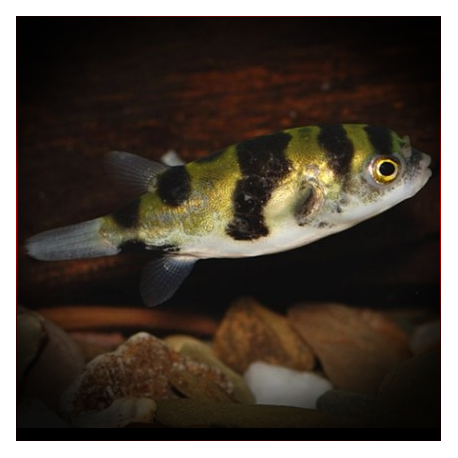More info
Datasheet
| Maximum Size | 3.5cm / 1.38inches |
General Description
Colomesus Tocantinensis is a species within the Tetraodontiformes order, commonly known as puffers. They are characterized by specific anatomical features such as a notched opercle, light yellow dorsal body coloration, and dark bands along the body. Puffers have the unique ability to inflate their bodies when stressed or threatened, achieved by drawing water or air into a specialized stomach diverticulum. They swim using a distinctive combination of pectoral and median fin movements termed "diodontiform" swimming.
Aquarium Setup
The species Colomesus Tocantinensis may not yet be seen in the aquarium trade, keeping in mind its peculiarities and requirements based on its natural habitat. For specific aquarium setup details, refer to the table provided.
Behaviour
Puffers like Colomesus Tocantinensis are known for their ability to produce sounds by grinding their jaw or vibrating the swim bladder. Their unique swimming style and defensive responses, including inflation, make them captivating additions to an aquarium. Puffers are primarily adapted to marine environments, showcasing distinctive behaviors in captivity.
Feeding and Diet
The diet of Colomesus Tocantinensis typically consists of small invertebrates and algae. Puffers are known to have toxic flesh due to toxins such as tetrodotoxin or saxitoxin, acquired through their diet or bacterial symbiosis. Understanding their dietary needs and potential toxicity is essential when caring for these species.
Reproduction & Dimorphism
Limited information is available on the reproductive habits of Colomesus Tocantinensis. However, closely related species like C. asellus exhibit spawning behaviors similar to marine puffers. These species have high fecundity, lay relatively small eggs, and do not provide parental care. Understanding their reproductive strategies is crucial for their successful breeding in captivity.
Habitat and Distribution
Colomesus Tocantinensis is currently known only from the Tocantins River in Brazil. Their specific distribution is confined to this area, highlighting the need for conservation efforts to protect their natural habitat and ensure their survival in the wild. Understanding their habitat requirements is vital for their well-being in captive environments.

